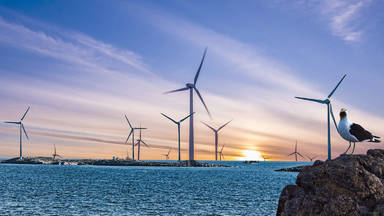
In our efforts to eliminate carbon emissions from the transportation sector, the largest share has always been devoted to the cars. We use this technology every day. The smell, sound and vision of the internal combustion engine are almost inevitable.
However, if we take time to study global carbon emissions, we will begin to see some invisible pollutants that have not caught the public’s attention.
But what about the remaining 88%? Many industries around the world are working hard to eliminate their carbon footprint, and each industry is pushing innovative technologies to its goals. The shipping industry is one of them, responsible for about 2% of global emissions.
The vast majority of them are container ships, accounting for 80% of world trade. Surprisingly, there aren't millions of cargo ships in the world that transport our goods. Maersk is the world's largest shipping company, with a 17.6% share in the global container shipping market, with a total of only 786 ships.
786 big ships.
Usually, these ships have a service life of 20 to 30 years, so it is important that we are ready to switch to carbon neutral technology when the time is right. The Triple E, the largest ship in the Maersk fleet, is roughly the same length as the Empire State Building.
The size of these ships is surprising.
The Triple E can carry more than 20,000 TEUs, which means it can carry ~20,000 (or exactly 20,568) standard 20-foot containers.
Therefore, the Triple E gearbox can provide more than 123 million pairs of shoes.
Enough to meet the needs of almost everyone in Japan.
This is crazy. These ships can easily be regarded as huge polluting equipment. Each of these ships has had an amazing impact on global waste.
Maersk produced more than 36.5 million tons of carbon dioxide in 2019, roughly equivalent to waste in small countries such as Ireland. However, if the toll is to be paid when the time comes, the freight efficiency will be very high, and it is much more efficient than other transportation methods. This number was close to 6 grams in 2007.
But Maersk did not invent a revolutionary technology to achieve this goal.
The fuel consumption of these tanks mainly depends on size, weight and speed. As each speed node increases, fuel consumption increases sharply, and the heavier the fuel tank, the greater the fuel consumption. The 8000 TEU container ship operates at 24 knots and burns 225 tons of fuel per day, Interestingly at 21 knots it only reduces the speed by 12.5%, but fuel consumption is reduced by 33% to 150 tons per day. The layoffs began in 2007, not because of concerns about climate change.
In order to save and reduce costs, transportation companies have tried to reduce fuel consumption, and this trend continues to this day, focusing on climate change. Reducing emissions by 42% is surprising, but reaching 60% by 2030 and 100% by 2050 will not be as easy as Maersk hopes. Reducing the ship's speed to reduce fuel costs is a game, and its revenue is reduced to less than 12-15 knots which is meaningless. To achieve 100% reduction, we only need to turn off the engine. This is a good way to reduce the global economy!
So what is the plan to reach 100%?
As these ships began to slow-down, something interesting happened. Their carefully designed structure stopped working as expected. The large hull of these ships have been carefully designed to reduce drag, but only when running at a constant speed. The deceleration of the ship disrupted fluid dynamics and prevented some drag reduction designs. The bulbous bow is a particularly effective device for large ships, reducing the resistance by up to 15%.
This is by no means a new technology.
In 1910, the first ships were installed on ships such as the Delaware. They work by generating a secondary bow wave that cancels the main wave generated by the hull through destructive interference.
In short, this technology reduces the energy loss in wave formation and also reduces the resistance to friction due to the reduced contact area between the ship and the water. The operating speed range of the model ship in 2007 was very narrow.
Today, the speed is not only getting slower and slower, but also changing greatly. The stand provided for this speed will not run fast. Therefore, as part of Maersk's fuel-saving efforts, they began to replace the bulbs in 2012 to adapt to the new low-speed operation.
Improve operation in the form of better steering software and autopilot technology, improve efficiency by adapting to efficient propeller and steering design, improve fluid mechanics by improving hull design or even simply cleaning hull and propeller, and provide better heat for everyone Recycling consumes fuel.
One of the most interesting changes in the industry is the direction of power return, which will further promote the development of these large ships. A long-term technology that supports the naval empire, such as West Holland Holland.
Modern ships have difficulty getting electricity from wind.
Transfer companies will not integrate solar energy resource if the equipments take up a lot of cargo space.
These rotors use the Magnus effect to generate pressure, which is exerted on them due to the surrounding air flow. When providing crosswinds, these rotors can provide high power for very low power input. Modern composite materials make the rotor lighter and therefore use less energy to rotate.
According to Norsepower, the world's leading sail technology provider for commercial shipping, its larger rotor can provide up to 3 megawatts of power to forward thrust. Basically, they are easy to set up and low-cost to maintain. They take up less space in your yard and reduce loss of income. They can be easily converted to different types of ships, and the rotors are controlled by a computer without any crew intervention.
The largest LNG fuel ship was launched two months ago.
This will eliminate many of the problems associated with heavy fuel oil and reduce carbon emissions by about 20%, but a large amount of methane will be released into the atmosphere, which is a stronger greenhouse gas. In the end, this fuel is still a useful fuel.
We can switch to biogas fuel, such as biogas or biodiesel.
Both of these fuels come from renewable methods that convert biomass into fuel, but their ability to remove carbon emissions is questionable.
Some methods help reduce the net production of carbon dioxide, while others have a worse environmental impact than fossil fuels.
Hydrogen is also an option, but it has its common disadvantages.
Basically, the current price is very expensive, but this has not stopped betting on hydrogen and other fields like Norway and Japan. The trucking industry, such as the long-distance road transportation industry, can get rid of the basic nature of the trucking industry and create important infrastructure on the first profitable personal route. Japan is one of the main gas stations on the transit route, connecting the two largest economies in the world, China and the United States.
Staying away from fuel will cause more problems. A major shift will result in gas stations in Alaska. Perhaps, if allowed, floating gas stations that generate hydrogen from offshore wind can serve these routes and continue to use the shortest route between China and the United States. Fortunately, the shipping industry is already very efficient, but there is always room for improvement.
We need to continue to put pressure on companies not only to clean up their technology, but also to prepare for the next step. We must look to the future and make the right decision. The transportation industry is the foundation of our modern world.









